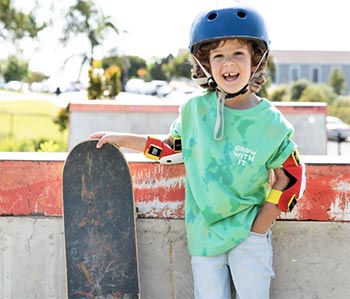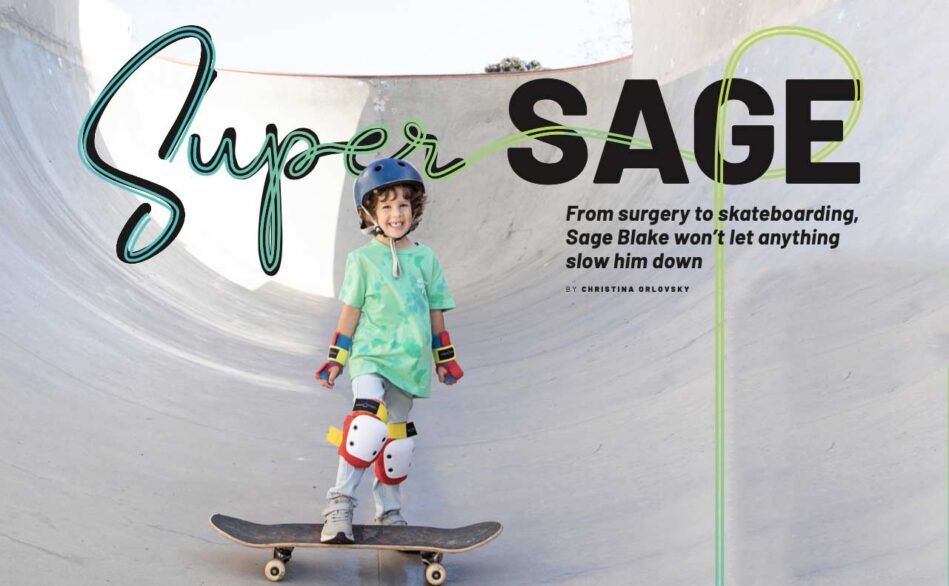When 5-year-old Sage Blake walked into his first day of transitional kindergarten last fall, his mother, Kimberly, was there alongside other teary-eyed parents waving goodbye to their kids as they embarked on a new chapter. However, unlike a lot of the other moms who were sad to see their babies growing up, Kimberly was crying tears of joy, watching her big boy walk bravely into the classroom for the first time. “For a long time, we didn’t think Sage would ever be able to go to school,” Kimberly recalls. “In the past five years, there have been so many milestones I never thought we would get to see.”
When Kimberly was five-and-a-half months pregnant, she learned her baby had a double aortic arch, a congenital heart defect that results in a second artery that extends from the heart and wraps around the trachea and esophagus. This can lead to difficulty breathing and swallowing. Kimberly, who already had a high-risk pregnancy due to her own epilepsy, now had further complications to worry about. Three weeks before her due date, she was put on bed rest due to elevated blood pressure. She was induced at 37 weeks, and within a few hours of labor, her baby’s heart was in trouble. His double aortic arch created a vascular ring around the trachea and esophagus. “We knew there was a high likelihood of me needing an emergency C-section, which is what ended up happening,” Kimberly says. “As soon as he was born, he cried, but then he started gargling. The respiratory team was already there, and they whisked him away. We had no idea what was going on until later that day. By the time I got to meet him, he was already intubated and hooked up to all kinds of machines. His CT showed that his double aortic arch was really tight. His breathing was labored, and he was really struggling.”
Sage spent the first week of his life in the neonatal intensive care unit (NICU) at another hospital before being transferred to Rady Children’s, where he underwent surgery to correct the double aortic arch at just 8 days old. But not before he and his family met a Rady Children’s doctor who was truly going to change Sage’s life.
A Life-Changing Meeting
After an exhausting day of hospital transfers and settling in at Rady Children’s, the Blakes met the team from ENT (ear, nose, and throat or otolaryngology) and Matthew Brigger, MD, chief of the Division of Otolaryngology at Rady Children’s and a professor of surgery at UC San Diego School of Medicine. He also leads the Center for Pediatric Aerodigestive Disorders and Airway Surgery, a multidisciplinary team of experts that specializes in complex airway and esophageal disorders. “I had no idea at that time how critical Dr. Brigger would be to our life,” Kimberly says. Dr. Brigger collaborated with John Nigro, MD, who leads the Heart Institute at Rady Children’s, to use the opportunity when Sage was under anesthesia during heart surgery to look at his airway. He discovered that Sage had complete tracheal rings, a birth defect that causes the normally C-shaped cartilage that protects the windpipe to form a complete O. This can result in severe narrowing of the windpipe that presents a variety of breathing and feeding problems.
“Sage was born with tracheal stenosis, a narrowing of his windpipe, which required major surgery,” Dr. Brigger explains. “He is the perfect example of the need for the Center for Pediatric Aerodigestive Disorders and Airway Surgery. We could fix the pipes, but he needed so much more. That’s where the feeding experts came into play.” Kimberly recalls: “Right after Sage’s heart surgery, that’s when our feeding journey began.” Sage had a nasal feeding tube inserted before heart surgery. “He was born on April 26, 2018, and he wasn’t able to bottle feed until the end of May,” she says. “I didn’t anticipate any of that. When you have a child born with trauma, you tackle whatever is put in front of you first. We knew about the heart issues, so that’s what we dealt with first. Then after his heart surgery, we learned more about the tracheal rings and how they were affecting his breathing and feeding. After the heart surgery, he was still having so much trouble breathing, so we knew the tracheal rings were causing even more distress.”
Sage’s Feeding Journey
For the next few months, Sage and Kimberly worked with the feeding team to learn how to do something that most of us take for granted: eat. While some of Sage’s physicians wanted him to have the nasal feeding tube for good, Dr. Brigger’s team wanted to help the Blake family feed without it. “To be honest, we just wanted to do whatever we could to keep Sage alive,” Kimberly says. “If it wasn’t for Dr. Brigger, our occupational therapist, Anne Mazzeo, my husband, and Sage fighting, we would have never gotten to where we are today. We were a true team.” While Sage was learning to feed properly, he was still awaiting surgery to repair his tracheal rings. Ideally, he would have been at least 6 months old at the time of surgery so he could be bigger and stronger, but he was still having such a hard time feeding, the family knew that they had to act faster. “Around early August, we shared our concerns with Dr. Brigger. Sage just couldn’t gain weight, and his breathing was really labored—it sounded like a rattle, and all of a sudden, he would stop breathing and then choke. Any way we sliced and diced it, it wasn’t working for him,” Kimberly says. At 4 months and 2 days old, Sage underwent his second major surgery, this time to repair the tracheal rings.
“It Got Worse Before It Got Better”
The period after surgery was the hardest in Sage’s journey. “This was a super traumatic time in our lives,” Kimberly says. “He was just in such critical condition for a week. For at least three or four days he was completely paralyzed under anesthesia. He didn’t even look like my child.” Still, through all the trauma, Kimberly was grateful to have the team at Rady Children’s by her family’s side. “When people ask me how we got through it, I say, it was a horrible time, but it was a great experience,” she says. “It’s a strange juxtaposition—what we were going through was so awful, but we were surrounded by such amazing people, from the nurses in the cardiovascular intensive care unit (CVICU) to Dr. Brigger to the people at the front desk! Everyone was so wonderful to us, and we felt supported the whole time.”
After a few more bumps in the road that included Sage pulling out his feeding and breathing tubes several times, the family finally made it over the hump. “Throughout it all, Sage was telling us what he needed. It was him saying, ‘I’m leading my journey, too, and I’m going to tell you what’s up!’” Kimberly says. “After he pulled out the feeding tube another time, Dr. Brigger had to fight to have it not put back in. He said, ‘Let’s see how he does without it.’ And guess what? He fed on his own! We’re only talking about a few milliliters of a difference, but still, he did it. They allowed our child to thrive, and he was thriving!”
Sage, the Soccer and Skateboard Star

It took a full year to get feeding down, but after that, there was no stopping Sage. By 18 months, he was on a skateboard. By 3, he was eating a hamburger. Now, at 5, there’s no limit to what he can do. “I remember early on, Dr. Brigger told me, ‘One day this will all be behind us, and you’ll be standing on the soccer field watching him play,’” Kimberly says. “It’s pretty impressive that this is where we are today.” Sage still sees Dr. Brigger for “routine maintenance.” He’s had his tonsils and adenoids removed, and he sees a gastroenterologist, a pulmonologist and an allergist. Still, for all that he’s gone through, he’s a “healthy, active kid,” his mom says. Not only is Sage healthy, he’s also happy. “People always tell me, ‘Your child has such a sweet soul. He’s so full of life,’” Kimberly adds. “I always say that he has such an appreciation for life because he fought so hard to get here. Plus, he spent the first six to eight months of his life flirting with nurses, so he’s got a great personality,” she laughs.
Kimberly has endless accolades for the team at Rady Children’s that shaped the first year of her son’s life and have supported her family from day one. “I tell people I will never leave San Diego unless my child’s surgeon relocates,” she says. “It is just so wonderful to have a doctor who genuinely loves my kid. Dr. Brigger’s passion for what he does and for the children he treats—and specifically for my child—is amazing. I am as strong of a mom as I am because of all the support we got. I feel so fortunate that we are in such good hands. Dr. Brigger is a super special person in my life and always will be.”
